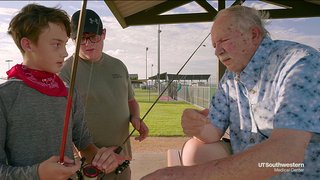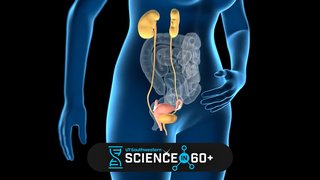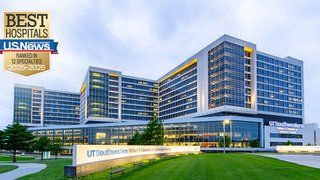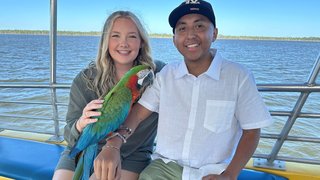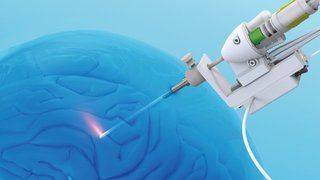Living-liver transplant: How a daughter gave her mom the gift of a lifetime
December 23, 2020

Robin Neely doesn’t have to worry about what to get her mother for Christmas this year. Or any year, for that matter.
That’s because in November 2019, she gave her mom a gift to last a lifetime.
During a seven-hour surgery in side-by-side operating rooms at UT Southwestern, the Frisco mother of four donated about 60% of her liver to her mother, Pamela Arrington, a former nurse who was suffering from cirrhosis. Pamela was sick enough to need a transplant, but not high enough on the waiting list to get a deceased donor transplant in time, and that made the mother-daughter duo ideal candidates to make history as UT Southwestern.
“I was very lucky to be chosen as UT Southwestern’s first living-donor liver transplant,” said Pamela, a 68-year-old Dallas resident. “I told my daughter that she didn’t have to give me any gifts for the rest of her life, because she gave me life.”
Nearly a year later, mother and daughter have recovered well and as the holidays approach they are urging others on the transplant waiting list to consider applying for the Living-Donor Liver Transplant Program at UTSW, which launched last year.
Pamela said she feels much more energetic – almost like a different person. Robin, 45, said within two months of the surgery her liver had regrown to normal size and she was able to resume activities such as driving, working, and even yoga.
“It’s such a short period of time to have this lifelong result,” Robin said. "And my mom are I are closer now in a way that not many people can be."
Too many ‘stuck in limbo’
There is a critical shortage of deceased donor livers in the United States; more than 13,000 patients are waiting to receive a transplant. Living-donor transplants provide a valuable way to shorten the waiting list and save lives.

“Many people are stuck in limbo like Mrs. Arrington,” said Dr. Parsia Vagefi, Chief of the Division of Surgical Transplantation and a liver transplant specialist. “They have symptoms of liver disease that interfere with their daily life but do not have access to a deceased donor transplant given their low MELD (model for end stage liver disease) score. These are people we can help through living-donor liver transplantation.”
The liver is the only organ in the body that has the ability to regenerate, said Dr. Arjmand Mufti, Medical Director of the Living Donor Liver Transplant Program. It performs more than 200 vital functions, directing metabolism, glucose, lipids, clearance of toxins, bile production, and clotting factors – to name just a few. “The liver is the workhorse of the body,” said Pamela. “You just don’t realize how much it does for you.”
UT Southwestern launched its liver transplant program in 2007, and built on that foundation under the leadership of Dr. Jorge Marrero, Professor of Internal Medicine and Medical Director of the Liver Transplant Program. In 2018, Dr. Vagefi, a liver transplant specialist, was recruited to UT Southwestern and brought Dr. Steven Hanish, an expert in living-donor liver transplantation.
Under their direction, the program rapidly grew to complete 95 liver transplants in 2018 and 115 liver transplants during 2019, representing the highest volume program in North Texas. Health care providers throughout William P. Clements Jr. University Hospital – from radiology to the ICU – have become more familiar with seeing liver transplant patients.
The team felt confident in taking on the logistical and technical challenges of living-donor surgery.
“It requires two operating rooms with two surgical and nursing teams located side by side, working simultaneously and overlapping,” said Dr. Vagefi. “That adds a lot of complexity – in addition to the fact that the technical donor and recipient operations are also both very complex.”
Since UT Southwestern’s first living-donor liver surgery in November 2019, two more surgeries have occurred under the program and more are in the planning stages. Interested donors must be healthy and have a relationship with the recipient.
'She saved my life'
Pamela Arrington and Robin Neely discuss the journey they embarked on together in November 2019 when they became the first living-donor liver transplant patients at UT Southwestern. The mother and daughter are eager to share their story in hopes it can help others waiting on the transplant list.
Nervous moments for mom and dad
Pamela didn’t learn of her daughter’s intention to donate until she’d nearly completed all of the required testing and paperwork. And that was probably a good thing, she said.
“It was scary knowing what I’d be going through with a transplant operation,” Pamela recalled. “When I heard my daughter wanted to donate, I worried twice as much.”

In several ways, the family was a perfect fit for this type of surgery.
“Robin enjoys good health. Her mom, Pamela, was sick enough from cirrhosis to greatly benefit from transplantation, but unfortunately not high enough on the waiting list to get a deceased donor transplant in time.” said Dr. Hanish, Surgical Director of the Liver Transplant Program and the Living-Donor Liver Transplantation Program. “So, living donor liver transplant was the ideal option for her. And both of them had a great support system in place, which is also essential for recovery from such a complex procedure.”
After talking through it together, the entire family felt comfortable putting their trust in the expertise of the UT Southwestern team.
“They have a very good reputation for being excellent at what they do,” Robin said. “We certainly found that to be true at every level. The whole team, every player is in the process is so important.”
While the clock was ticking, Phil Arrington, who has been married to Pamela since 1971, kept an anxious watch in the waiting room.
“My wife and daughter were both in major surgery at the same time. I’d never felt anything like that before,” he said. “The procedure went like clockwork. The staff at Clements was outstanding and I saw such pride and joy in them when my wife and daughter were rolled out of surgery.”
Mother and daughter spent five days at Clements University Hospital. “We saw each other right before the surgery and every day in the hospital,” Robin said.
Since then, the two have only strengthened their bond – especially throughout a year dominated by the COVID-19 pandemic.
“I’ve always felt close to my daughter,” Pamela said in December 2020, “But I think we’re even closer now. Well … she saved my life.”
Sharing their gift
Pamela and Robin are eager to share their story in hopes it might help someone else find the gift of living-donor liver transplantation. It's a life-saving option that not enough people know about.
“There are patients out there who have not been referred yet due to their low MELD score, because they think they won’t have a chance at a liver transplant,” said Dr. Mufti. “We find them all the time – people suffering from liver disease who would really benefit from living-donor liver transplantation. Our team is here to give them that opportunity.”
For more information about the UT Southwestern Living-Donor Liver Transplantation Program, please visit our website or call 877-392-1528, where our intake coordinators are available 24/7 to answer your questions.




